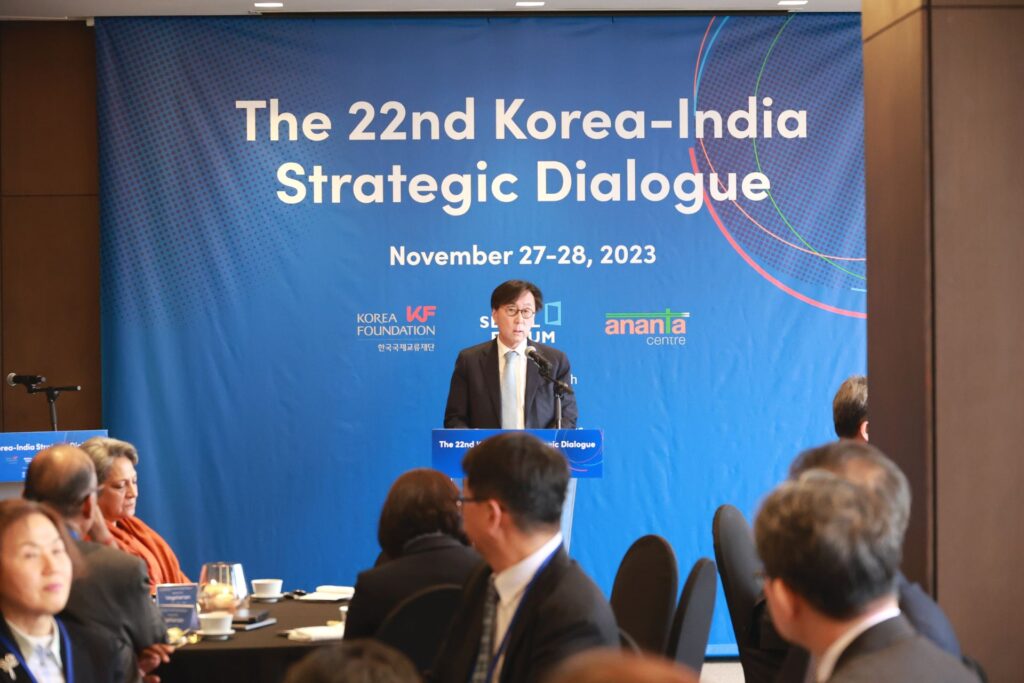A terror attack near Pahalgam on April 22, claimed by the Pak-based Lashkar-e-Taiba (LeT) offshoot The Resistance Front (TRF), resulted in the loss of lives of 26 tourists. In an unsuccessful attempt to disturb communal harmony in India, the terrorists killed their victims after ascertaining their religion. The immediate response of the Government of India was to curtail the remaining links with Pakistan and hold the sixty five years old Indus Waters Treaty (IWT) in abeyance “until Pakistan credibly and irrevocably abjures its support for cross-border terrorism”.
Operation Sindoor (OS)
The profound public anger and the kinetic punitive action taken by India after the Uri and Pulwama terror attacks had made a similar response inevitable this time. Initiating OS on May 7, India hit nine terror targets in Pakistan, including the headquarters of LeT and Jaish-e-Mohammed (JeM) at Muridke and Bahawalpur, both in Pakistan’s Punjabi heartland. The deep and multiple-target precision strikes were qualitatively different from the single-target Balakot strike in 2019. The Indian armed forces produced ample proof of the damage caused, which was largely acknowledged by Pakistan. The strike was a just payback not only for the Pahalgam attack, but also several innocent lives lost in earlier attacks. It was also a strong warning to Pakistan against continued use of terror as an instrument of state policy.
Pakistan resorted to heavy firing across the LoC, causing civilian casualties; and on the night between May 7 and 8 made an unsuccessful attempt to engage several military targets in northern and western India. In response, India targeted air defence radars and systems in a number of locations in Pakistan. Thereafter, in the cycle of aerial attacks and counterattacks, India inflicted damage on several air bases in Pakistan, including the Nur Khan base located near the Pak army headquarters and Pakistan’s nuclear arsenal nerve centre, Strategic Plans Division (SPD), in Rawalpindi. Eventually, the Indian Foreign Secretary announced on May 10 that during a phone call initiated by Pakistan’s Director General Military Operations (DGMO) to his Indian counterpart, the two sides had agreed to stop all firing and military action from land, air and sea. However, India made it clear that OS was only suspended and Pakistan’s actions will be closely monitored.
To put the Indian decision to agree to cessation of military action in perspective, while announcing the May 7 strikes, India had described them as “measured, non-escalatory and proportionate”, adding that only terror infrastructure had been hit and no Pakistani military establishments were targeted. It was also emphasised that Indian armed forces were “fully prepared to respond to Pakistani misadventures, if any, that will escalate the situation.” Implicit in this statement was India’s intent not to escalate unless Pakistan retaliated. Having delivered its punitive strikes on the terror targets as a strong message of deterrence to terrorists and their mentors, there was no need for India to do so. However, Pakistan retaliated by trying to engage Indian military targets. The aerial attacks and counter-attacks that followed were the result of Pakistan’s repeated provocation in attacking military facilities in India. Therefore, when Pakistan eventually came around to accepting stoppage of military action, it was logical for India to do likewise. It would have made no sense for India to continue the military exchanges any further without a clear objective.
Prime Minister’s address to the nation- Operation Sindoor (OS) a new normal
In an address to the nation on May 12, Prime Minister Narendra Modi said that OS had set up a new normal in India’s fight against terrorism. He made three specific pronouncements:
-
If there is a terrorist attack on India, a befitting response will be given on India’s terms and strict action will be taken going to the roots of terrorism.
-
India will not tolerate any nuclear blackmail and will strike precisely and decisively at terrorist hideouts.
-
India will not differentiate between the government sponsoring terrorism and masterminds of terrorism.
A powerful statement of intent, how will it work in practice?
S. No. 2 has to be seen in the context of Pakistan indulging in nuclear blackmail in all crises with India since Operation Brasstacks in the late 1980s, both to deter India and arouse the anxieties of the international community to invite intervention by major countries, notably US. It has also tried to enlist the support of the international community for its dubious Kashmir agenda by describing it as a nuclear flashpoint. It has treated the nuclear dimension as a shield to carry out acts of terror against India with impunity. After its nuclear tests in 1998, Pakistan had started saying that India had no military options under the nuclear overhang. India, on the other hand, believed and has demonstrated through its military action in Kargil in 1999, cross LoC punitive operations from time to time and the Balakot strike that it continues to have military options. In fact, by striking nine terror targets deep in Pakistan under OS, India has expanded the space for such options under the nuclear overhang.
Pakistan has deliberately maintained an evolving, ambiguous nuclear posture. However, it has from time to time spoken of its nuclear redlines. Thus during Operation Parakram in February 2002, Lt. Gen. Khalid Kidwai, head of SPD referred to four scenarios that could lead to the use of nuclear weapons: India conquering a large part of Pakistan’s territory (including PoK) or destroying a large part of its armed forces or pushing Pakistan into political destabilisation or strangling Pakistan economically. Pakistan has also spoken of using tactical nuclear weapons in response to India’s Cold Start doctrine. Reacting to the recent Indian move on IWT, Pakistan said that any attempt to stop or divert the flow of water belonging to it will be considered an act of war and “responded with full force across the complete spectrum of national power.” From the above, it will be seen that in spite of its frequent nuclear sabre rattling, in the Pakistani thinking, their nuclear arsenal is a deterrent to an escalation/ all-out war or any other action by India to give a crushing blow, threatening Pakistan’s very existence. India’s military actions thus far have stayed well below these redlines.
However, while the nuclear dimension has not completely ruled out the use of conventional military power by India, it is a limitation on India’s ability to secure a durable change in Pakistan’s behaviour by giving it a crushing blow militarily. The international community remains averse to any escalation between the two nuclear armed neighbours that could by accident or design approach the nuclear boundaries. This was yet again evident from the calls for restraint from major countries during the recent crisis. We ourselves too may not like to test those boundaries.
As for S. No. 3, Pakistan used cross border terror as an instrument of state policy brazenly till 9/11. However, due to the change in the stance of the international community post 9/11, it started describing its terror proxies as ‘non-state actors’ or denying their very existence. Since the terrorists active against India have been reared, nurtured, supported and directed by Pakistan’s security establishment, India has all along rejected the above arguments. After the Balakot strike in 2019 and the recent targeting of 9 terror sites, India emphasised, with a view to containing escalation, that its action had covered only terror targets and not any military installations. Prime Minister Modi’s pronouncement suggests that in future, India will not make a distinction between terrorists and their mentors in Pakistan’s state structure.
The pronouncement at S. No. 1 is the key to making OS the new normal. It implies that future terror attacks would result in kinetic punitive action by India as in the case of OS, presumably combined with such non-kinetic steps as India may deem fit. OS resulted in military exchanges, entailing costs, over four days. The exact costs on both sides may never be known, though Pakistan seems to have borne heavier costs, both because of reports of damage to its military installations and its much smaller economy. Nonetheless, the conflict entailed costs for India too. Such costs are not only human and economic, but also in terms of distracting us from other key national goals and greater volatility on our western frontier at a time when our security imperatives on the LAC have grown. There are also costs on account of India-Pakistan hyphenation and international focus on Kashmir in the wake of such military exchanges. Will India be willing to incur such costs following every terror attack, big or small?
There is also the ever preset challenge of escalation control. While ambiguity in such cases is useful to create uncertainty in the mind of the adversary, the use of the word ‘befitting’ by the Prime Minister seems to suggest that India’s response may be proportionate to Pakistan’s criminal act in each case. Further, while the need to address public outrage after a large terror attack results in pressure on the government to take publicised punitive action, covert punitive activity and grey-zone tactics, with lesser chances of an escalation, should in general be the preferred option.
The current equilibrium not stable
The cessation of military action has by and large held and the two DGMOs have been in touch. The Indian Army has said that the May 10 understanding to stop all firing and military action has no expiry date and both sides will continue confidence building measures to reduce the alertness level.
However, the existing equilibrium is far from stable and could unravel with another terror attack or some other provocation from Pakistan. Only dialogue between the two sides can impart greater stability to the situation. In his X post on May 10 concerning the “ceasefire” agreement, the US Secretary of State Marco Rubio had referred to an agreement between the two sides to start talks on a “broad set of issues” at a neutral site. Rubio’s reference to talks was either the result of a misunderstanding or he jumped the gun in making it. India has denied any such understanding, but left the door open for dialogue by saying that talks will be only on restoration of PoK to India and terrorism. This is not likely to be acceptable to Pakistan. A recent report in the Pakistani daily Dawn quotes PM Shehbaz Sharif as saying that Saudi Arabia could be the venue for the talks; adding that Kashmir, water, trade and terrorism will be the key points of discussion. Even though in the absence of adequate infrastructure, India’s ability to influence flows of water to Pakistan is limited for the moment, suspension of IWT, a lifeline for the water stressed lower riparian, could hurt Pakistan significantly in the medium to long term. Therefore, Pakistan would be keen to see India abide by the treaty. India has signalled no intent to discuss this issue. In view of the divergent positions of the two sides, any reference to talks and what may be discussed remains in the realm of speculation.
Looking ahead
Looking ahead, the moot question is whether the tactical success of OS will translate into a strategic success in putting an end to Pakistan sponsored terror. There is no simple answer to this question. In spite of India’s stern message of deterrence, there is a surreal atmosphere of triumphalism in Pakistan and claims of having “thwarted India’s aggression”. It presents the picture of anything but a chastised country. The army has consolidated its position, at least in the immediate. However, OS will create uncertainty in the minds of Pakistan’s terror planners. The army will need some time to replenish its armament losses and plug the weak gaps, identified during the recent military action, inter alia, by acquiring new weapon systems. Therefore, they may refrain from any large scale terror attacks at least for some time.
However, there is no ground whatsoever to expect, especially with a hawkish army chief and the current mood in Pakistan, that the army-led Pakistani establishment will dilute its adversarial posture towards India or give up its corollary- the instrumentality of terror. OS, though a psychological blow, does not appear to have degraded appreciably Pakistan’s terror machinery. The top leadership seems to be intact barring some prominent names killed in Bahawalpur. In any case, in the highly radicalised Pakistan, its army has a large pool to recoup the losses of terror leaders and cadres. There would certainly be some adaptation in abandoning the earlier brazenness of maintaining prominent terror centres, and taking the terror activity underground. However, our counter-terror grid should always remain in top gear. Pakistani terror against us has gone down significantly from its heyday, but in spite of their best efforts, our security forces cannot prevent the adversary from slipping through our defence lines occasionally. Therefore, the goal of zero terror is unrealistic.
Lastly, in view of the anticipated greater volatility on our western frontier in the aftermath of OS and the continued enhanced security commitments on the LAC, there is a strong case for a significant ramping up of allocation of resources to our armed forces.
The previous issue of Pakistan’s Baloch Conundrum (Af-Pak Digest) are available here: LINK
























